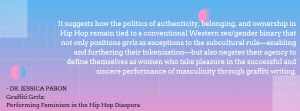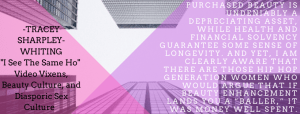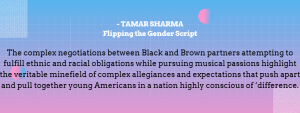Throughout the duration of this course, I felt like my entire *limited* perception of hip hop expanded beyond what I imagined, to include a better understanding of where hip hop originates to its mass global effects today.
Learning about the transcendence of hip hop as a voice for the marginalized and voiceless to a global capitalist sensation- and everything in between- has been one of the most interesting aspects of this course. I think that hip hop, particularly rap music, has evolved in an interestingly generational way, and to learn its trajectory through very facets has provided unique perspectives to my own perception of feminism.
This semester, the quotes/readings/materials that stuck out to me the most were those that demanded space and recognition for the smaller, underappreciated groups even within an already marginalized subculture.
Through the course of these readings, and futhermore my qoutes, I was drawn to that which spoke against the common image or “face” of hip hop: Black and/or Latino masculine men. While mysogny, toxic masculinity, and homophobia are certainly not consequential problems of hip hop, they are real structures that the subculture operates on.
A frequent topic we read about and discussed in class was the agency of women over their physical presence, sexualized or not. Again, while hip hop may not be the only arena where women face the dichotomy of presentation, it occurs frequently enough that every woman in the hip hop game, whether an MC, dancer, or graffiti grrl, discusses the decision of whether or not to embrace femininity- they must make the choice to either push masculinity to be taken seriously or be “one of the guys” or push femininity and hyper sexualize themselves to sell.
Even more interesting are the complexities in this conversation of dichotomy. Where is the line between a woman showing her body and allowing the hyper sexualization of herself driven by a demand from the industry and the right to do with her body as she pleases? And realistically, how do we contend with the fact that consumers will both hate her for being a “slut” and yet desire more from her? Who is her audience?
Even arguably centering the conversation around body and image aids in the removal of her contributions to hip hop as an art form, as an industry, and as a long lasting legacy. It is the Hip Hop feminist that seeks to not only subvert the disenfranchisement, but chooses to make their own legacy on their terms – as irretractable pieces of hip hop.
This myraid of disenfranchised voices- and the effort not only to make space for the present, but to not lose the past- needs not forget the presence of queerness in hip hop spaces.
Which is, of course, an extention of misogynistic views perpetuated not by but within the subculture…
I thought it was interesting to look at the way we view black sexuality, for all genders, in heightened ways that I truly had not fully grasped before this course. And furthermore, the way that black and brown bodies are equally fetished and admonished in the same breath.
I think the thing that continues to draw me to these readings in particular also comes from the original intentions of hip hop, to find a way to express their circumstance and create something out of nothing. Hip Hop practitioners, whether they consider themselves feminist or not, have persisted in finding a means of communication in a society that refuses to hear them. That transformative power is spanning across countries and cultures.
I chose the color scheme above because it reminded me of The Get Down, in both costumes, effects, and era, as well as being reminiscent of graffiti pieces sprinkled throughout the semester.
I’ve included a list of the quotes below, as my pictures look to be coming out blurry:
“By 2000, hip hop had become a global tour de force, marking out terrain in both mass culture- where its dominant appeal lay- and on the level of the subcultures- where its dynamism resided.”
“In one sentence, George attempted to wipe out our contribution to the culture beyond tokenizing, marginalizing, and compartmentalizing, saying that we haven’t had a real or significant impact on a culture that we have participated in as writers, rappers, artists, managers, publicists, filmmakers, supporters, journalists, photographers, b-girls, graf girls, and in every other capacity you could think of, since the beginning of hip hop. This passage gives us an easy target, but points to the notion carried by many folks in and around hip hop culture that simply is not true.”
“It suggests how the politics of authenticity, belonging, and ownership in Hip Hop remain tied to a conventional Western sex/gender binary that not only positions grrlz as exceptions to the subcultural rule—enabling and furthering their tokenization—but also negates their agency to define themselves as women who take pleasure in the successful and sincere performance of masculinity through graffiti writing.”
“Purchased beauty is undeniably a depreciating asset, while health and financial solvency guarantee some sense of longevity. And yet, I am clearly aware that there are those hip hop generation women who would argue that if beauty enhancement lands you a “baller,” it was money well spent.”
“Graffiti art provides a gritty, unexpected, and relentless public commentary on the politics of ownership and the question of public space under settler colonialism, imperialism, and capitalism. It is a subculture that uses the power of words to communicate—even when the image is but an illegible name proclaiming presence, even when the writer knows she must kiss her creation goodbye.”
“So for me, the conversation is not just about the reclamation of hip-hop by Queers, as is seen in the budding gay hip-hop and Homohop movements in the U.S, but a reexamination of how we’ve reimagined hip-hop in the ways that have de-emphasized and discounted queer presence.”
“I just think its a much more complicated conversation than Black people- especially Black men, critics, artists, and consumers alike- want to have because it would require an examination of the way patriarchy functions intracommunally. Open conversations about homophobia as an extension of sexism and misogyny would put a lot of stuff on the table that gets dismissed in the name of silencing and erasing inappropriate faggotry.”
“ The down low prompts a reterritorialization of black sexual identification, as it substitutes for both bisexuality — a sexual identity — and being closeted — a practice that privileges discretion. In this regard, the down low places a stricture on black (sexual) expression, which is most clearly seen in the case of black celebrity.”
“The complex negotiations between Black and Brown partners attempting to fulfill ethnic and racial obligations while pursuing musical passions highlight the veritable minefield of complex allegiances and expectations that push apart and pull together young Americans in a nation highly conscious of ‘difference.’”
“Obviously, some might ask: What potential does a song like this offer to the development and implementation of land ethics? The answer, of course, is that expressive Native art and thought like that witnessed in “Solarize” stand to creatively disseminate a land ethic across generations, different tribal communities, and perhaps even to non-Native communities because of the cultural crossover potential of hip hop as a musical form.”











